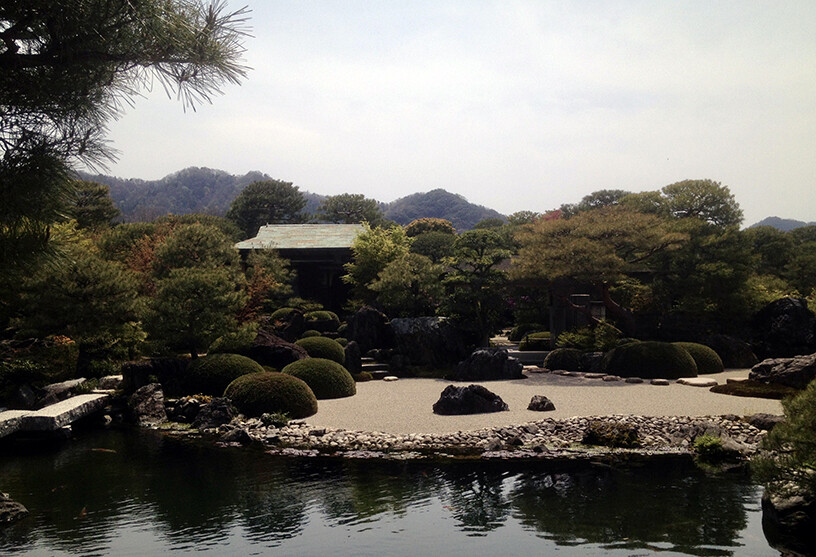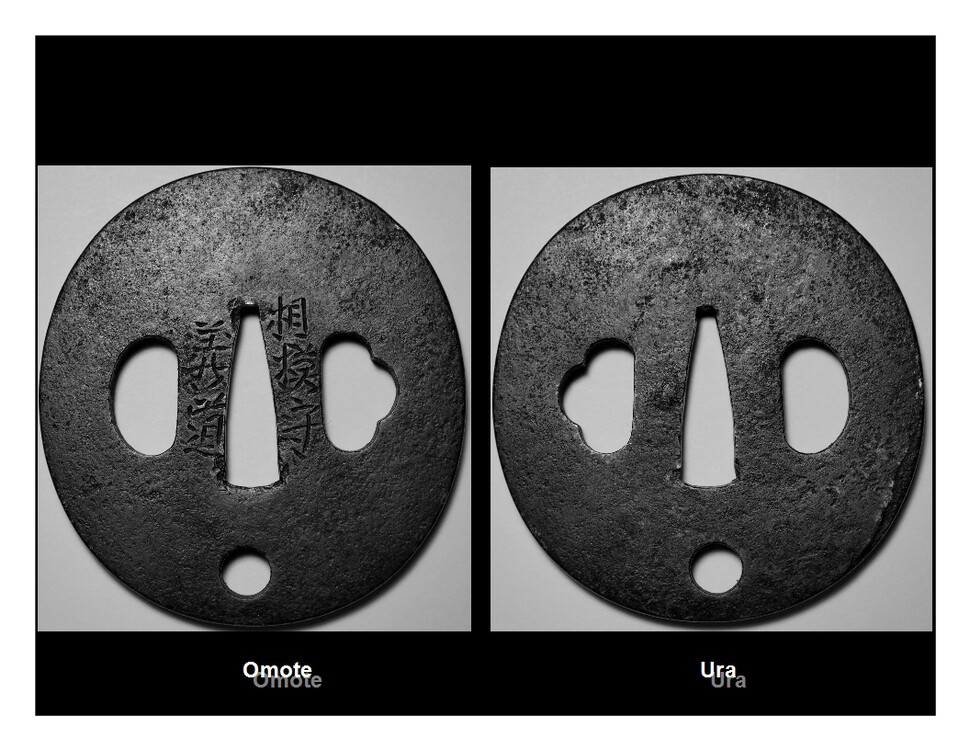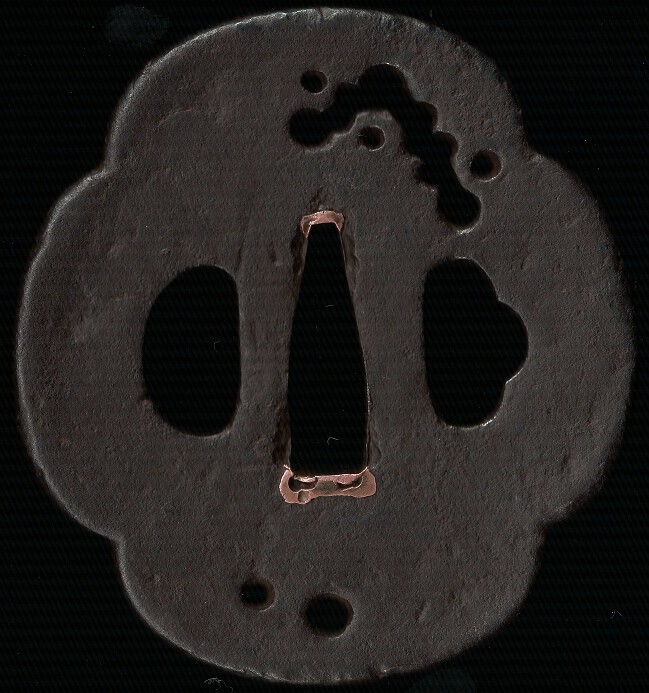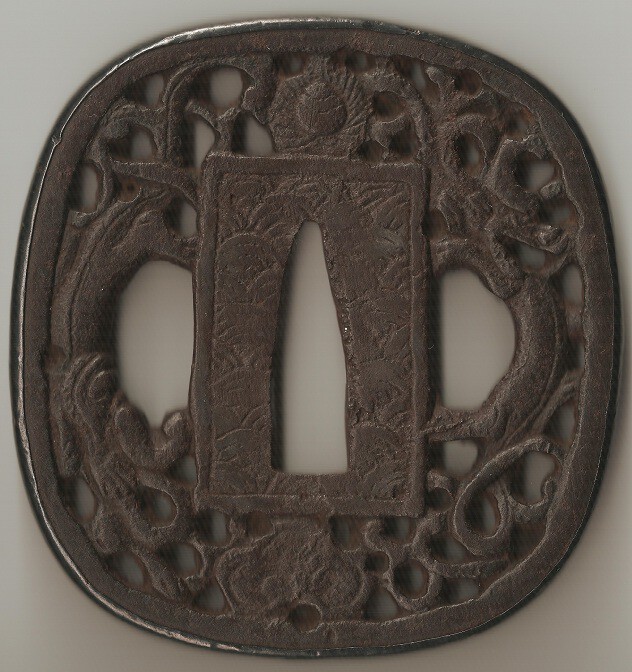-
Posts
2,886 -
Joined
-
Last visited
-
Days Won
3
Everything posted by Soshin
-
Hi Everyone, The debate is long dead on this thread but I want to post some new photos I did of the "gimei" tsuba in question. I was also able to photograph the nice iron bones along the rim as well. The glossiness and color of the patina is nicely captured in the photos. Enjoy. P.S. I love my new digital camera. Go Olympus! :D Yours truly, David Stiles
-
Hi Andy, Thanks for the reply. It brings the discussion back into focus and not so off topic. In conclusion I will say I like iron bones the more the better! This I a am sure of more research is not necessary. I am a scientist at my day job and a fine art collector on the weekends. Your truly, David Stiles
-
Hi Eric T., Thanks for the link. It has many nice and free examples to study. The photos are good quality as well. Yours truly, David Stiles
-
Hi Christian, I cam across this article which is part 1 of 2 on Rich T. Kodogu no Sekai: http://kodogunosekai.com/2006/12/19/the-goto-shirobei-family-by-mosle/ Second part was on the blog on Jan. 2007 a month later. It might have some helpful information. Its also have some nice Ko-Goto menuki examples. Hope you find this helpful in your study. Yours truly, David Stiles
-
Hi Chris, The point of my post was to state that my original Yamakichibei tsuba was that the techniques used to forge the plate was of armorsmiths origin. I think tekkotsu are independent of carbon content and its movement during the forging process. The Tosho tsuba who I think is made of steel with what I think has high carbon content show no tekkotsu along the rim just evidence that it was forged folded. Yours truly, David Stiles
-
Hi Everyone, I think the data and the comparison between the Yamakichibei tsuba example I provided with many "iron bones" tekkotsu and details of carbon migration in Nihonto may not be a valid comparison due to differences is forging methods. It think the initial comparison with Momoyama Period armor provided most recently by Ian Bottomley and first by Andy M. even with the short comings pointed out by Ford is a more valid one give that many of the techniques used to forge the plate of the tsuba were adapted from armor making. Attached is photos of a tsuba made by a documented swordsmith. The signature mei (銘) from right to left top to bottom of nakago hitsu-ana is: Sagami (no) Kami (相模守), Yoshimichi (義道). This swordsmith who worked in the city of Kyoto ((京都) in Yamashiro Province (山城國) also made tsuba. Two generations are recorded in both W. Hawley's Japanese Swordsmiths (First Edition ID# Y0920) with a 10 point score and R. E. Haynes's Index of Japanese Sword Fittings and Associated Artists (ID# H 11843.0). This tsuba was made by the second generation that signed his work using Sagami (no) Kami (相模守) circa 1750. The plate surface shows no hammer marks only a polished smooth surface migaki-ji (磨地). The rim is square in shape and lacks any tekkotsu "iron bones'. The rim does show some lamination folds with one coming to the surface on the ura (裏) side. The only openwork design on this tsuba is the single enlarged udenuki ana (腕貫穴) used to prevent the sword from being drawn accidentally. Based upon the large size of the nakago-ana and overall weight of the tsuba I think this was likely mounted on a katana (刀) or o-wakazashi (大 小刀) even with the diameter of the tsuba being relatively small at 7.0 cm X 6.5 cm with a thickness at the rim of 5.5 mm. The analysis of this type might be helpful. P.S. Nice work Mark Green I love your tsuba that posted. Keep up the good work! :D Yours truly, David Stiles
-
Hi John, To restate again my main point of the earlier post and to answer your question the evidence is anecdotal at best and not scientific. I collect what I like to see I don't collect tsuba for scientific study I collect them as fine art. Yours truly, David Stiles
-
Hi Henry, Nice tsuba I almost purchased it in Florida last month. Its good to hear it went to a good home in the land of its birth. :D This idea of alternating negative and positive arrangement of elements I have seen in on other mon related tsuba. Here is a example from my collection that originally came out of the same old US collection as your tsuba. Notice the alternating negative and positive elements of the kuyo mon (九曜紋) design used by the Hosokawa family. I think my tsuba is from the Momoyama Period. The thickness of the plate is very small at about 2.0 mm at the rim. The overall size of the tsuba is 7.2 X 7.0 cm. Yours truly, David Stiles
-
Hi Ford, On the issue of the ryo hitsu-ana of my Yamakichibei tsuba they are original from my in hand observation of the tsuba and were not added after the yakiteshitate process. I think this can be observed from looking at the inside surface of the openings. In regards to the sekigane they were added much later likely after the tsuba was remounted on another Nihonto. If you had not notice in the my last post I presented just anecdotal evidence from looking at tsuba in my collection about the hardness of different schools of tsuba without any strong scientific and empirical evidence. To answer your original request I think in the world of tosogu that is all you have from Torigoe's time until now. In the end I think it would be a really fun PhD dissertation to study such a topic to produce some real scientific evidence in this field of study. I think the problem with trying to recreate the masterpieces of old in your backyard like Mark G. is that in the end you don't have a master showing you the fine details of forging and the finishing (ex. yakiteshitate etc.) of the tsuba making process along with the correct materials to use. For example with tamahagane there are many different grades based upon carbon content likely some where used for tsuba making while others not so much. Alternative idea would be that different grades of tamahagane were used in specific ratios. The use of nanban tetsu "southern barbarian iron" and its use in making Nanban tsuba adds another dimension to the issue. This is not to say that Mark G. haven't been able produce any fine tsuba. Yours truly, David Stiles
-
Hi Ford, Thanks for posting such a interesting topic for discussion. I can generally tell if a tsuba has underwent additional heat treatment (aka annealing) in Japanese yakiteshitate because many of the sukashi or other details including even the mei would appear to be melted almost like butter. You can often find this on Yamakichibei tsuba. Steve W. would be a good person to ask for some additional examples. I think these tsuba have one of the hardest iron because of the additional heat treatment. Very close in hardness to Yamakichibei tsuba are the Saotome school tsuba as well but these tsuba I don't think had any additional heat treatment. This might be because of the carbon content or other factors but I am not sure. Here is a Yamakichibei tsuba in my collection which had heat treatment applied. Notice the melted appearance of the ko-sukashi and mei. If you look under low magnification the surface is shiny. This might also be a effect of the heat treatment. I think some of Torigoe's statements are subjective but I do think there are tsuba with harder iron then others. Hardness being just one of many other characteristics of the specific iron used to make the tsuba. Yours truly, David Stiles
-
Hi Ed F., Here is the nanban tsuba I was talking about in my collection and the poor scan I did. Similar in a way to Fred G. problem posted on his website. Notice how the inside parts of the nanban-bori are so out of focus. I do notice that I did get a good contrast between the jet black sakudo mimi and the brownish-black color of nanban tetsu of the tsuba. I really need to re photograph this tsuba because it looks much better in hand then it does in this poor scan. Yours truly, David Stiles
-
Hi Ed F., I can see where a scanner would be better for Nihonto then tosogu. An additional reason I wanted to link to Fred G. website was that the tsuba he is selling look much better in person on then on website. Tonight after work I will post the nanban tsuba I own I was talking about in the earlier post. Yours truly, David Stiles
-
Hi Ed F., It really depends on the tsuba. If the tsuba is flat all scanners I know of have a fix depth of field have no problems but a tsuba with a big change in height due to carving, hammering, style of open work, and overall change of the surface height can make parts of it appear out of focus obscuring some detail. Not to pick on Fred G. but here is a link to his website: http://www.swordsandtsuba.com/tsuba/nanbanpg1.html. Take a look at the third Nanban tsuba from the top and notice how out of focus it is. I have a nanban in my collection that did the very similar thing when I tried to scan it. Is this enough detail answer to your question? Yours truly, David Stiles
-
Hi Christian, In terms of age I would say that it is likely dependent of the characteristics of the iron including but not limited to the color. In Rodenbacher opening post he stated something about the tsuba having "iron bones" or tekkotsu along the rim. I was thinking this is more likely a characteristic of Owari Sukashi tsuba from early Edo Period. By the middle to late Edo Period the "iron bones" became very rare even in Owari tsuba generally speaking. I don't see any in his photographs but this type of detail of the iron requires a nice digital camera to document. I know this from my own personal experience. I do notice what you are talking about the poor shape of the kozuka and kogai hitsu-ana which may indicate a later production. I don't think really anything can be resolved until we have some better photos of the tsuba in question. For this very reason I paused my collecting to do some learning and purchased a new digital camera and other critical photographic equipment. Yours truly, David Stiles
-
Hi Rodenbacher, Without correct color balance the patina can look way off. From the above quote and other information provided the tsuba this is likely a early Edo Period Owari tsuba. With that said I can't really confirm anything until I see the tsuba in hand give the photos provided. I like the design thanks for sharing. Yours truly, David Stiles
-
Hi Henry W. and Fred D., I purchased it over a year ago from a dealer who is also my broker to submit things to the NBTHK. I didn't pay much for it at all sigificately less then the gimei example sitied by Henry. When I use the term "gimei" I should have used quotes. As you are correct Herny only in the eyes of the NTHK and NBTHK is it considered a gimei. In historical reality it was likely a early Edo Period Yamakichibei school work. Thanks again for the comments and discussion. Yours truly, David Stiles
-
Hi Everyone, Here is a composite of three different photos I taken of a tsuba in my collection. I invested in a completely new digital camera, lens, tripod, and head to take the photos. The design of this Yamakichibei tsuba is of a dragonfly kachimushi (勝虫) made in part by the kozuka-hitsu ana facing a pine tree done in Ko-sukashi (小透). The surface has nice hammer marks Tsuchime Ji (槌目地). The patina sabi (寂) is also very dark brown-black indicative of Edo period Yamakichibei gimei (偽銘) copy from Owari Province. Granular iron bones tekkotsu (鉄骨) are present all along the rim and in some places on the surface of the tsuba itself. The measurements are 7.0 cm X 6.5 cm and 3.0 mm at the rim but thinner at the seppa-dai. Comments and questions are welcome about the photos or the tsuba. :D Yours truly, David Stiles
-
Hi Rodenbacher, No this tsuba doesn't look like anything I have ever seen. It must have been heavily altered at some point. I collect the Tempo school and this doesn't look like at all the work of that school. Thanks for posting photos. Maybe someone else can give it a try. Yours truly, David Stiles
-
Hi, I would say Owari Sukashi school. The rim and how the ji-sukashi is done (squareness) all look Owari to me. The ji-sukashi design is bold and symmetric characteristic of Owari but also doesn't look dynamic enough to be Shoami School. The color of the patina of the iron does look off in all the photos which could just be poor lighting or a white balance issue. Can you provide better photos under natural sunlight or other better lighting? Thanks. Yours truly, David Stiles
-
Hi Alan and John, The Ko-Shoami school makes sense and the shumei was a attribution added later. This also makes sense given all Ko-Shoami are unsigned. Yours truly, David Stiles
-
Hi John, Well give the limited information I not going to try to identify the tsuba. As for the shumei is likely just a latter attribution someone made as to the maker of the tsuba. I have seen this more often on Nihonto. The Hoami would use gold in there attribution signatures of muei Nihonto. Over the weekend a friend show me a Nihonto he had with a gold attribution mei made by a Hoami who made the attribution in the Edo Period to what is a Koto tachi that was shorted and the signature lost on the nakago. I don't think a tsubako would ever use a shumei in signing their work. Yours truly, David Stiles
-
Hi John, What are the measurements of the tsuba including thickness at the rim (mimi) and near the center (seppa-dai)? Having better photos would be helpful but I can understand if you can't get them easily. Yours truly, David Stiles
-
Hi Ed, I think you need to look at more quality tsuba. A hammered back mimi does not look like that. The only thing I do see is multiple casting defects. To be honest I would recycle those cast tsuba if they were ever mounted on a real Nihonto I owned. They look bad and they have little or no value. This is just my opinion. Go ahead and post the other tsuba you were talking about above. Yours truly, David Stiles
-
Hi Ed, I would agree with Larenzo and others points the tsuba looks like a cast iron copy of a original Edo Period kinko tsuba. Both tsuba will be considered as shirimono. There are iron nanako but it doesn't look like this. I have a good example in my collection. Let me know if a good example of real iron nanako would be helpful. Yours truly, David Stiles
-
Hi Ed, Sorry I am not to familiar with the Yoshiro school often referred to as the Kaga Yoshiro school. I don't know much about the early brass inlays schools in general. I only have one brass inlay tsuba in my collection and that is a Onin tsuba from the middle to late Muromachi Period based in Kyoto. Here is another example I found searching on the Google: http://www.giuseppepiva.com/index.php/kaga-yoshiro-tsuba.html?___store=us&___from_store=it. I hope you find what little information I have helpful. Yours truly, David Stiles








